#misadventures in monstrology
Explore tagged Tumblr posts
Text
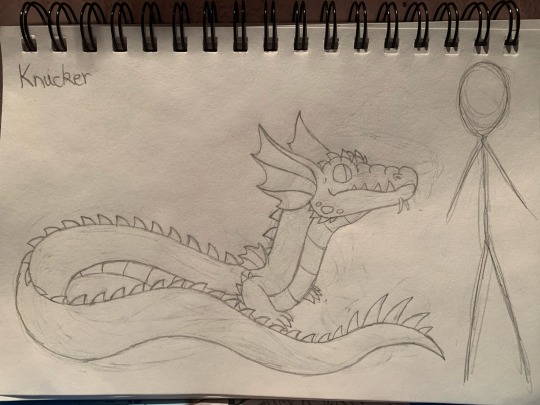
Knucker (Lindworm felpalus)
Habitat: swamps, lakes
Size: 10 feet long
Coloration: dull green, brown
Diet: rabbits, waterfowl, fish, carrion
Magical Abilities: toxic breath, acceleration of plant growth, toxin removal
So Smaugust is here, and I do not have the energy to draw for the entire month. I still want to participate in it, and I thought of the perfect plan for it!
So I haven’t really discussed it much here, but I’ve been planning out a fantasy setting and story in my head. I’m calling the planned story “Misadventures In Monstrology”.
Ever since I was a kid, I’ve been deeply enamored with zoology, so I feel the fantasy story I am going to tell should have zoology as its heart, like how language is the heart of Middle Earth. It’s somewhat disheartening how uncommon fantasy biology is as a trope. So someone has to step in, and I’m gonna be that someone!
Some major inspirations for this setting are the Dragonology and Monstrology books, the Flight of Dragons movie, @tyrantisterror’s Midgaheim Bestiary, and @draconesmundi. (I think you’d both like to see this!)
So in this universe, monsters such as dragons exist due to magic. While magic doesn’t allow for too much craziness (there won’t be much fairytale logic), it does allow monsters to gain mutations that would be strange or impossible otherwise, and also allows them to locally control the elements.
Dragons are squamates (having evolved from monitor lizards), but that doesn’t mean there won’t be any hybrids. Chimeras also exist in this universe, basically through a fantasy version of horizontal gene transfer, which is a real thing with some rotifers! I am planning to make them kinda rare, because I mainly want to do it with creatures that make the most sense (and are more interesting to me) as chimeras, like griffins, pegasi, and some dragons I’ll end up drawing eventually…
Also, I felt I should talk about this dragon. A knucker in English folklore is a sort of water dragon, but unlike sea serpents, they dwell in freshwater “knuckerholes” rather than the ocean. They’ve got a lot in common with wyrms like the Lambton Worm and Hydra in folklore, with how they’re aquatic serpents. So they’re more like lindworms in appearance, rather than the more common modern portrayal of them having four legs.
Design wise, they’re very much based on crocodilians with their heads and back spikes, since they are swamp dwelling reptiles. They’ve also got some amphisbaenian in them, which is kinda inevitable considering their body plan. Also, they’ve got barbels like a fish to kinda add to the swamp creature aesthetic. Poison breath seemed like a given, the magic over plants is due to them probably living in more lush areas, and I like the idea of their body kinda absorbing the toxins they breathe out, keeping their environment healthy.
If you wanna keep up with these posts, click my #field guide to dragons tag which will update throughout the month! Or follow me, if you'd like.
Next ->
#artists on tumblr#dragons#worldbuilding#speculative biology#fantasy#smaugust#misadventures in monstrology#wyvere draws#field guide to dragons
58 notes
·
View notes
Text
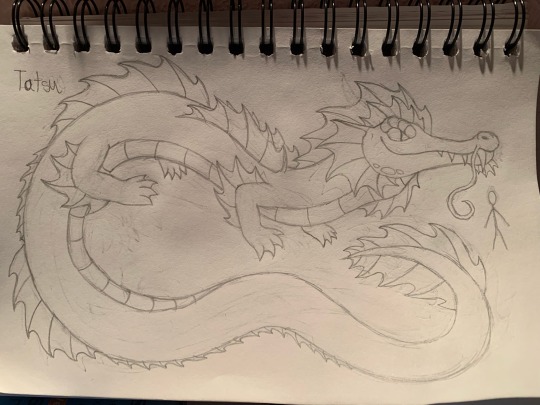
Tatsu (Long heishui)
Size: 40 feet long
Habitat: pelagic oceans
Coloration: black, gray
Diet: large fish
Magical abilities: steam breath, pseudogills, storm manipulation
Today’s dragon is the tatsu! They kinda caused some headaches for me, actually. You see, the direction associated with Heilong, the dragon this is inspired by, is the north, specifically the north of China. But I wanted this dragon to be the “ocean king” archetype in Asian legends, because they correspond with the Water phase and all. Buuuuut I could just handwave it somehow since this setting isnt real life with magical creatures, maybe there’s a saltwater lake that leads to the ocean or something, or north is the north ocean, idk. Anyway, a fun fact: according to legend, the first emperor of Japan descended from dragons!
The name tatsu is Japanese in origin, and is an alternate word for ryu, I went with the former since seiryu contains “ryu” in it, so it felt weird to me. They’re mainly based on the archetype of sea dragons in Asian myth, which is especially common in Japan. There’s also some basis from the jiaolong, with how they don’t have horns, a unique trait amongst the other dragon species. Obviously, their breath weapon is water related, being a blast of scalding steam.
I’ve gotten praise for the unique face designs of each dragon, so I wanted to give these fellows a head based on the gharial. It just fits perfectly. While usually amicable with humans, tatsu do tend to be somewhat more territorial than their kin. One hypothesis for why this is posits that they could have encounters with leviathans that managed to swim to the oceans they dwell in, but due to the general difficulty of observing what goes on at sea, nothing is wholly proven.
26 notes
·
View notes
Text
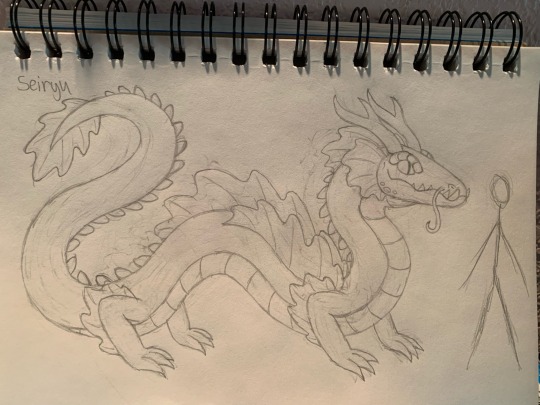
Seiryu (Long qingmu)
Size: 20 feet long
Habitat: forests, lakes
Coloration: blue, green
Diet: fruit, fish, fowl
Magical Abilities: fertilizing breath, accelerated plant growth
Last time, I mentioned that I was doing a little theme with the Asian dragons. That theme would be the philosophy of wuxing, or the Five Phases. Corresponding with the Five Phases are the Four (or sometimes Five) symbols, which includes the Azure Dragon/Qinglong, or as they’re called here, Seiryu.
I choose the name Seiryu because another dragon species is called the long and it feels weird to have a different species with a name that includes that. The specific archetype this species is based in are some freshwater dragons like the dilong and panlong.
The plant powers are due to Qinglong being associated with the phase of Wood. The fertilizing breath is a mist that makes plant life grow, which combined with their diet including seeds can make them basically breathe out plants (this concept was inspired by the flash game “How to Raise a Dragon”).
Seiryu are very important maintainers of their environment, allowing for a lot of plant life to grow with their very presence. Thus, a lot of human settlements are stationed around their forests, as their presence brings a good harvest and more than enough trees for the multitude of uses for wood. The seiryu don’t mind, as it doesn’t cause them any exhaust, and they like to have chats with the locals from time to time.
13 notes
·
View notes
Text
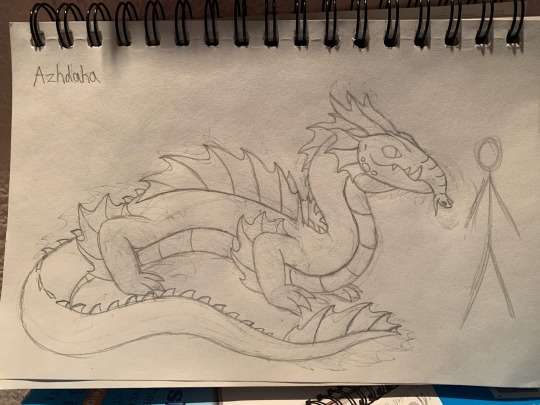
Azhdaha (Long baijin)
Size: 15 feet long
Habitat: coasts
Coloration: white
Diet: rabbits, birds, fish
Magical Abilities: electric breath, flight
Today’s dragon is our first dragon inspired by Asian folklore, the azhdaha! They’re not really a type you see a lot in modern media, or at least I haven’t seen any. There is a dragon in Genshin Impact named after them, which is pretty neat. I will admit, I haven’t found too much info on them, and a lot of sources seem to have the same info on them? If anyone is more knowledgeable on them, I’d love more info! Actually if you have additional/especially obscure info on dragon folklore, please share it with me, I love learning about dragons!
The azhdaha is a dragon from Persian legend, appearing in several stories, usually as an antagonist. Something interesting about them to me is the sort of crossover between European and East Asian dragons in their nature. They have the usually antagonistic role of European dragons, and the physical appearance of Asian dragons. Which does make sense, since they’re geographically sandwiched between the regions those come from.
The electric breath is something I added in, because they don’t seem to have a breath weapon in folklore, and also to do with a little theme I’m doing with all the Asian inspired dragons, which I’ll explain with the next dragon. But for now, the fact that these fellows are coastal is from their lore of starting life out as terrestrial snakes, and then being banished to the ocean once they reach maturity. They usually dwell in coral reefs, so they’re like sharks in their ecology.
17 notes
·
View notes
Text
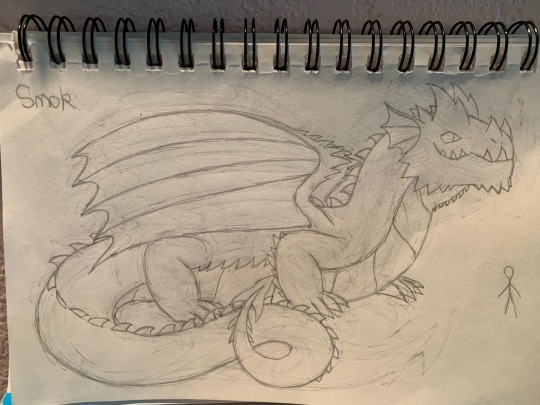
Smok (Stiliodraco ignis)
Size: 60 feet long
Habitat: mountains, tundras, forests, volcanoes
Coloration: red, brown, green, gold, black
Diet: mammoths, behemoths, pretty much megafauna in general
Magical Abilities: fire breath, flight
After those weird and wacky wyrms and wyverns, it’s about time we move onto the most recognizable archetype of dragon, the four legged flying firebreathers, the most basic of bitches, the many children of Smaug, the… well, they don’t actually have a name. See, this archetype is so omnipresent that it’s seen as the definition of dragon, despite the existence of so many other interesting types of dragon. It’s not like I hate seeing them or anything, but can we get some wyrms in media? Please?
Anyway, the specific name “Smok” is from Polish folklore, and most would recognize it from Smok Wawelski. I can’t think of a better name for this archetype, so it’s what I’m using. This one’s more based on modern fantasy dragons than medieval dragons, as the first dragon that resembles the modern idea of a dragon was drawn in 1260. Actually, I was originally gonna have the smok be an ice dragon and the fire dragon named “Urolok” from Tolkien’s elven language, but when the nidhogg became the ice dragon, I used Smok for this one, which will also probably piss Tolkien’s lawyers off less.
Something I wanted to do with the design is make them look weirder than the DnD red dragon design clones, but not extremely bizarre. And I think I managed that! I based them somewhat off of the thorny devil, which I’m kinda surprised I haven’t seen a dragon that resembles one. Their spiked wings are very much based off of several dragons in Monster Hunter. I very much imagine these fellows to be big megafauna hunters, and also probably nature’s defense against the forest-eating behemoths (which aren’t dragons in this setting, so they won’t be in this field guide, sorry). They actually wouldn’t care for humans, not just because of a moral opposition to eating creatures that can talk, but because humans are just so small that they don’t have enough nutritional value for them to be worth hunting down.
13 notes
·
View notes
Text
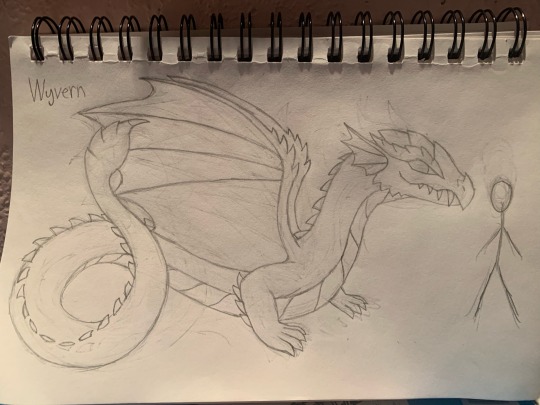
Wyvern (Wyvern scorpius)
Habitat: hills, jungles, savannahs, deserts
Size: 15 feet long
Coloration: green, yellow, purple
Diet: deer, canids, eagles
Magical Abilities: venom breath, stinger tail, flight
Oops, haven’t updated this in a while! But I think the majestic wyvern is worth the wait, especially due to being the first dragon that isn’t a lindworm (though they probably are part of the same family). Wyverns are interesting, because two legged dragons are pretty common in modern media due to realism. But while I couldn’t care less about the limb amount of dragons (except dragons with a single pair of limbs or none at all, we need so much more of those), the wyverns I find the most interesting are the ones that are their own kind of dragon rather than the one combined with the modern western dragon. The fierce, stinger-tailed dragons are fun monsters!
Wyvern isn’t actually the only name for a winged dragon with two legs. Zilant is probably the more accurate term for this dragon since their legs are the forelimbs, but since wyvern is the more famous name, it’s the one I’m using. Plus, I’m pretty sure zilants don’t have stingers. Also a fun fact about the etymology of “wyvern” it’s closely related to the word viper, and since vipers give live birth, wyverns in medieval folklore produced milk because I guess they were trying to draw more comparisons with mammals. Though there are spiders that produce milk, so it’s not like a reptile producing milk is impossible…
Venom breath and venomous stinging aren’t really magical abilities, but the venom comes from a sac in their bellies rather than their mouths, and no regular reptile has a stinger tail, so magic did allow them to evolve those. Also, the wyvern is the first dragon able to fly, with large back frills and manipulation of wind. In fact, this flight allows them a large range, with them even being able to be found outside of fantasy medieval Europe, a nod to folkloric wyverns being thought to exist in Africa. They’re very much similar to birds of prey in their ecology, being flying apex predators. Oh, and if you’re reminded of Rathalos while looking at the design, that is very much intentional.
#artists on tumblr#dragons#fantasy#speculative biology#misadventures in monstrology#field guide to dragons#wyvere draws
18 notes
·
View notes
Text
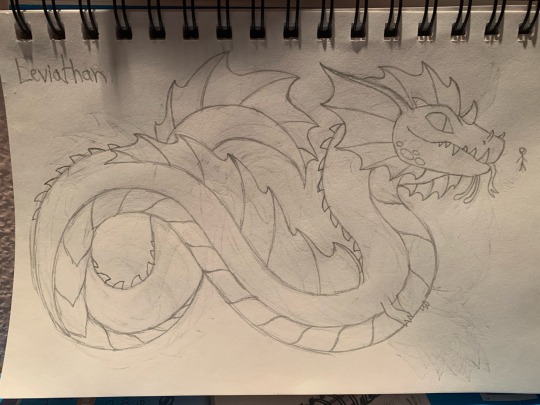
Leviathan (Lindworm magnummare)
Size: 100 feet long
Habitat: epipelagic zone, ocean abyss
Coloration: blue, gray, green (red markings)
Diet: large fish, dolphins, sharks, seals, small schooling fish and squids
Magical Abilities: necrotic breath, pseudo gills, pressure resistance
From Tiamat to Leviathan to Jormundgandr, sea serpents are some of my favorite dragons, but unfortunately, a lot of works seem portray them as the lesser kin of “true” dragons, if they’re related at all. Even Dragonology has them as separate from dragons, even when they have the obscure knucker and the entirety made up marsupial dragon. And I say that’s bullshit! Sea serpents are just as awesome as flying fire breathing dragons! In fact, I say they’re even more awesome, and that’s why I’m putting them in my fantasy setting!
The name Leviathan is specifically from the Biblical monster of the sea, but there’s traits from a lot of other sea serpents. Instead of the biblical Leviathan’s fire, their breath weapon is a black necrotic liquid which the Norse Jormundgandr would spit out. I believe I’ve seen stuff about how sea serpents have a single horn upon their forehead, but I don’t quite remember where.
Their ecology is pretty similar to toothed whales, being active predators in the open ocean. Unlike toothed whales, they’re able to indefinitely be underwater due to magic, and can even dive into the abyss completely fine. That’s part of why they have red markings (red is the first color to lose visibility underwater). I considered making them bioluminescent, but I scrapped that. They use glowing tools, though! As for design basis, a lot of it is pretty standard sea serpent, but the little legs are based on a lizard I saw in a tumblr post, since they wouldn’t use their legs for walking or anything.
#artists on tumblr#dragons#fantasy#speculative biology#misadventures in monstrology#field guide to dragons#wyvere draws
19 notes
·
View notes
Text
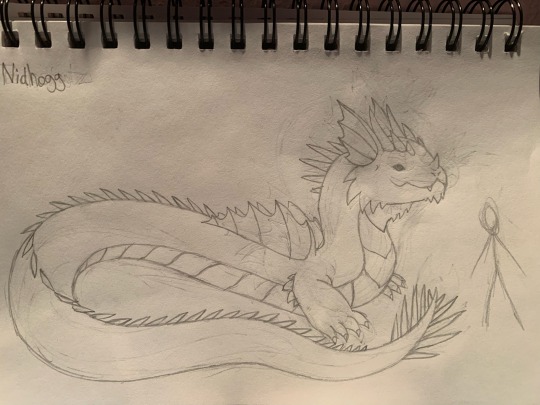
Nidhogg (Lindworm cuniculus)
Habitat: tunnels, subterranean caverns
Size: 30 feet long
Coloration: white, blue, pink, gray
Diet: cave bears, skolexes, carrion, tree roots
Magical Abilities: frost breath, enhanced smell
Welcome back to Field Guide to Dragons! Today, we’ve got the nidhogg!
In Norse myth, Nidhogg is a specific dragon, who lives at the base of Yggdrasil and eats its roots and the corpses in Helheim. In Monstrology, nidhoggs are a species of dragon, who live a subterranean lifestyle and thus are near blind. I decided they’d have frost breath because another thing is that I didn’t want multiple dragons species to have the exact same breath weapon (except for chimeras), ice dragons don’t really exist in mythology, and I feel like ice powers work for a subterranean creature.
I should mention I also sprinkled some tatzelworm into this species with the feline face. I’m going with dragons being based on archetypes rather than evert specific variant in folklore, so I don’t overcomplicate things for myself. For example, the knucker is based on the archetype of freshwater wyrms, and the nidhogg is based on the archetype of terrestrial and subterranean wyrms. Back to physical design, I ended up leading more into the mole lizard than with the knucker, especially with the specialized limbs for digging and the tiny, near blind eyes. Also, they have a lot of thin spikes like that of a lot of fantasy ice dragons.
#artists on tumblr#dragons#fantasy#speculative biology#misadventures in monstrology#field guide to dragons#wyvere draws
2 notes
·
View notes